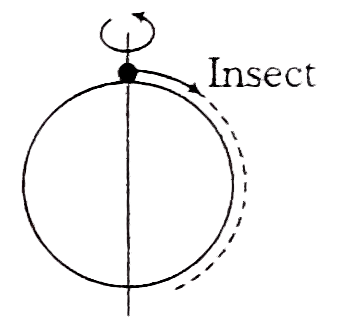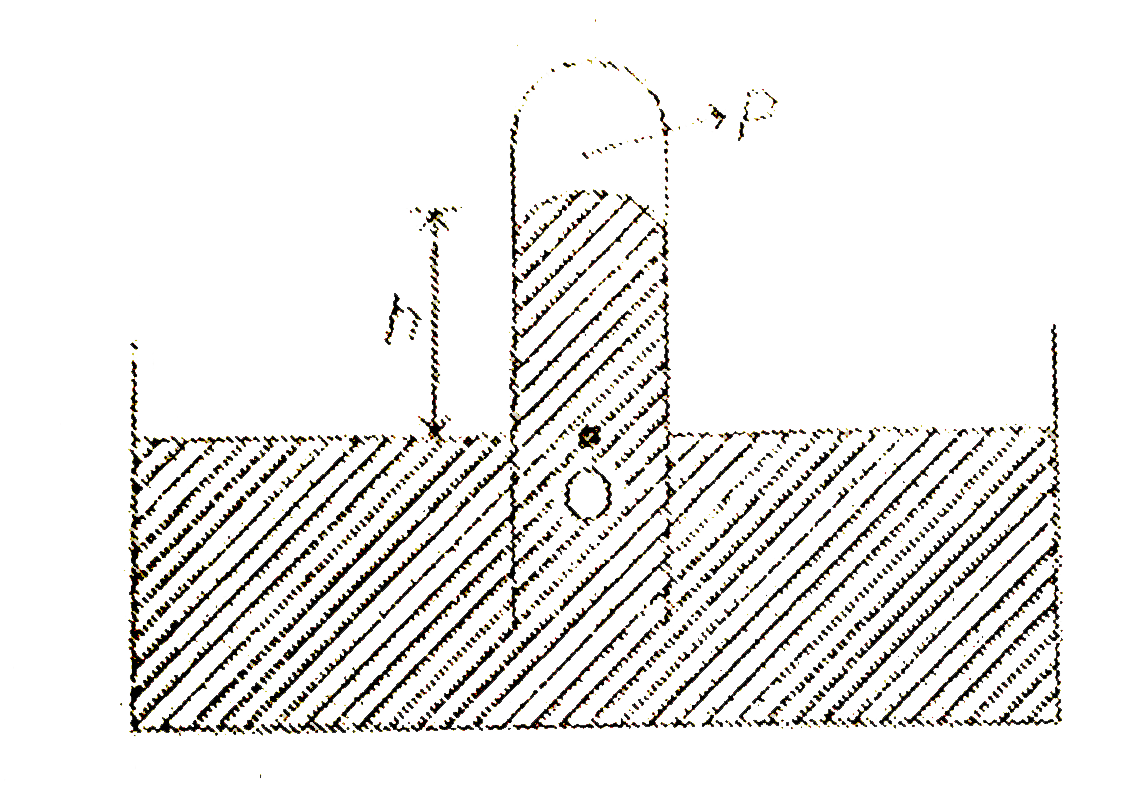A solid sphere is rotating about an axis shown in figure. An insect follows the dotted path on the circumference of sphere as shown in the figure.

Column-IColumn-II(A)Moment of inertia(p)Will remain constant(B)Angular velocity(q)Will first increase, then decrease(C)Angular momentum(r)Will first decrease then increase(D)Rotational kinetic energy(s)Will continuously decrease(t)Will continuously increase
The correct Answer is:(A→q,B→r,C→p,D→r)
Torque, τ=0
∴ L = constant, K=L22I and Iω= constant. Insect first moves away from the axis, then towards it. Hence, I will first increase and then decrease.
Topper's Solved these Questions
- ROTATIONBook:DC PANDEYChapter:ROTATIONExercise:(C) Chapter Exercises
Explore 39 Videos
- ROTATIONBook:DC PANDEYChapter:ROTATIONExercise:(A) Chapter Exercises
Explore 83 Videos
- RAY OPTICSBook:DC PANDEYChapter:RAY OPTICSExercise:Integer type q.
Explore 15 Videos
- ROTATIONAL MECHANICSBook:DC PANDEYChapter:ROTATIONAL MECHANICSExercise:Subjective Questions
Explore 2 Videos
Similar Questions
A solid sphere is rotating about an axis as shown in figure. An insect follows the dotted path on the cricumference of sphere as shown .
Match the following


View SolutionIf earth decreases its rotational speed. Match the following columns
Column-IColumn-II(A)Value of g at pole(p)Will remain same(B)Value of g at equator(q)Will increase(C)Distance of geostationary(r)Will decrease(D)Energy of geostationary satellite(s)Cannot say
View Solution
Knowledge Check
Column IColumn II(A)Moment of inertia(p)newton/metre2(B)Surface tension(q)kg/(metre-sec)(C)Angular acceleration(r)kg-metre2(D)Coefficient of viscosity(s)newton/metre(E)Modulus of elasticity(t)radian/sec2
A90∘B60∘C75∘D45∘
Two concentric spherical shells are as shown in figure. Match the following columns

Column-IColumn-II(A)Potential at A(p)greater than B(B)Gravitational field at A(q)less than B(C)As one moves from C to D(r)Potential remains constant(D)As one moves from D to A(s)Gravitational field decreases(t)None
View SolutionIf radius if earth is reduced to half without changing its mass, then match the following columns
Column-IColumn-II(A)Angular momentum of earth(p)Will become two times(B)Time period of rotation of earth(q)Will become four times(C)Rotational kinetic energy of earth(r)Will remain constant(D)(s)None
View SolutionIn elliptical orbit of a planet, as the planet moves from apogee position to perigee position to perigee position, match the following columns
Column-IColumn-II(A)Speed of planet(p)Remains same(B)Distance of planet from centre of sun(q)Decreases(C)Potential energy(r)Increase(D)Angular momentum about centre of sun(s)Cannot say
View SolutionColumn - IColumn - II(A)Coordination number(p)FCC(B)9 places of symmetry.(q)Line passing through centres of two diagonaily opposite edges(C)2 fold axis of symmetry(r)Decrease with increase in temperature(D)Coordination number = 12(s)SCC
View SolutionMatch the following . When an independent positive charge moves from higher potential to lower potential, then
Table - 1Table - 2(A)its kinetic energy(P)will remain constant(B)its potential energy(Q)will decrease(C)its mechanical energy(R)will increase
View SolutionMatch the following :
{:(,"Column-I",,"Column-II"),((A),"Velocity",(p),"Increased,"n uarr z darr),((B), "Potential Energy",(q),"Increased,"ndarrzuarr),((C ),E_(n)-E_(n-1) (E="Total energy for H atom "(n cancel(=)1)),(r ),"Decreased,"n uarr ),((D),"Separation energy (For H atom)",(s),"No change"n uarr):}
View SolutionA tube is inverted in a mercury vessel as shown in figure. If pressure P is increased, then

∣∣ ∣ ∣ ∣ ∣ ∣∣Table-1Table-2(A)Height h(P)will increase(B)Pressure at O(Q)will decrease(C)Pressure at 1 cm(R)will remain sameabove O∣∣ ∣ ∣ ∣ ∣ ∣∣
View Solution

